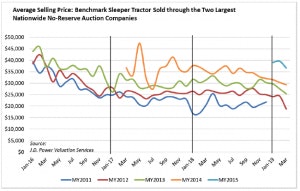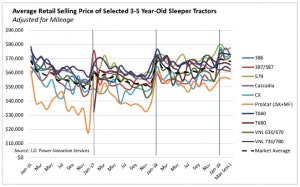
In the auction market, J.D. Power says, “The winter lull in auction activity is behind us. March data provided our first real look at how the market is holding up in 2019. Volume of our benchmark model was up by an expected proportion over February, but fell well short of last March.”
J.D. Power’s benchmark model for March shows model year (MY) 2016 tractors averaged $42,750, $3,550 (7.7 percent) lower than February; MY 2015 averaged $36,600, $3,000 (7.6 percent) lower than February; MY 2014 tractors averaged $29,250, $1,050 (3.5 percent) lower than February; MY 2013 tractors averaged $25,400, $2,175 (7.9 percent) lower than February; and MY 2012 tractors averaged $18,750, $5,650 (23.2 percent) lower than February.
For the quarter, J.D. Power says four- to six-year-old examples in its benchmark model brought 4.3 percent more money than in the same period of 2018.
“Going forward, year-over-year comparisons should reach parity and then turn mildly negative,” J.D. Power says. “Freight-focused economic measures are less stable than last year, but we expect pricing to remain relatively healthy through the second quarter.”
J.D. Power says in the retail market the volume of late-model trucks sold in March was similar to February, although dealers sold incrementally more trucks in total. The company adds trucks with less-desirable specs and mileage are not faring as well as in previous months.
J.D. Power says the average sleeper tractor retailed in March was 69 months old, had 467,319 miles, and brought $55,808. Compared to February, that average sleeper was identical in age, had 3,209 (0.7 percent) more miles, and brought essentially identical money. Compared to March 2018, J.D. Power adds this average sleeper was two months newer, had 5,140 (1.1 percent) more miles, and brought $7,321 (15.1 percent) more money.
In the popular three- to five-year-old cohort, prices were as follows:
- MY 2017: $82,804; $7,037 (7.8 percent) lower than February
- MY2016: $67,908; $4,138 (5.5 percent) lower than February
- MY2015: $57,332; $915 (1.6 percent) lower than February
Measuring on a year-over-year basis, J.D. Power says late-model trucks sold in the first three months of 2019 brought 10.6 percent more money than in the same period of 2018. On average, trucks in this age range depreciated 3.3 percent per month in the first quarter of 2019, compared to 2.5 percent in the same period of 2018. Value trends in 2019 are looking more historically typical than in 2018 — though late-model, low-mileage trucks are still in short supply.

Finally, medium-duty trucks had a weak month across the board, with lower volume and pricing for the three main segments of the market.
J.D. Power says March’s average price for Class 3-4 cabovers came in at $14,944. This figure is $1,875 (11.1 percent) lower than February, and $1,542 (9.4 percent) lower than March 2018. Class 4 conventionals averaged $19,924 in March. This figure is $2,477 (11.1 percent) lower than February, but $1,003 (5.3 percent) higher than March 2018. Class 6’s averaged $21,178 in March. This figure is $4,279 (16.8 percent) lower than February but, like the conventional market, $1,233 (6.2 percent) higher than March 2018.
In forecasting for the remainder of 2019, J.D. Power says “the big question is how many trucks the economy will need in 2019. There are two obvious factors pointing to flat or downward demand. First, the manufacturing side of the economy stopped ‘front-loading’ raw material inventory in mid-2018. This strategy was employed to avoid potential tariff increases on Chinese materials. Second, exports have contracted, as a symptom of a cooling global market and the ongoing impact of the tariff war. Other economic measures are also looking less hot than last year, but it’s too early to identify any trends just yet.”
For more information, and to read the entirety of this month’s report, please CLICK HERE.









